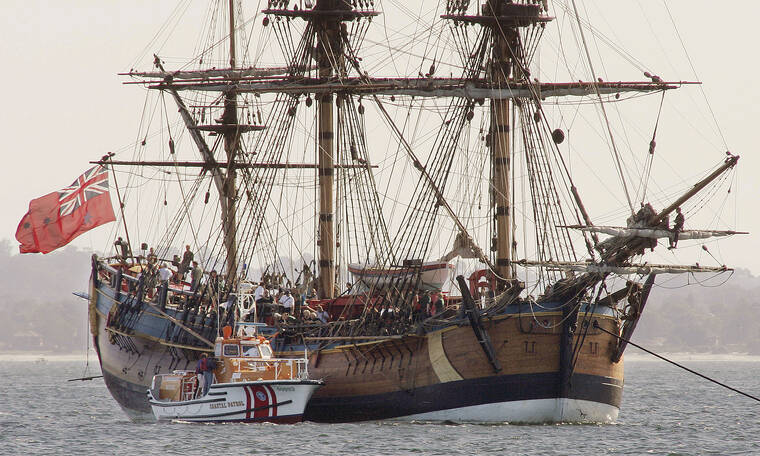In the dawn hours of January 18, 1778, on his third expedition, British explorer Captain James Cook on the HMS Resolution and Captain Charles Clerke of the HMS Discovery first sighted what Cook named the Sandwich Islands (that were later named the Hawaiian Islands.)
Cook continued to sail along the coast searching for a suitable anchorage. His two ships remained offshore, but a few Hawaiians were allowed to come on board on the morning of January 20, before Cook continued on in search of a safe harbor.
“At nine o’clock [January 20, 1778}, being pretty near the shore, I sent three armed boats, under the command of Lieutenant Williamson, to look for a landing-place, and for fresh water. I ordered him, that if he should find it necessary to land in search of the latter, not to suffer more than one man to go with him out of the boats.”
“Just as they were putting off from the ship, one of the natives having stolen the butcher’s cleaver, leaped overboard, got into his canoe, and hastened to the shore, the boats pursuing him in vain.”
“The order not to permit the crews of the boats to go on shore was issued, that I might do every thing in my power to prevent the importation of a fatal disease into this island, which I knew some of our men laboured under, and which, unfortunately, had been already communicated by us to other islands in these seas.”
“With the same view, I ordered all female visitors to be excluded from the ships. Many of them had come off In the canoes. Their size, colour, and features did not differ much from those of the men ; and though their countenances were remarkably open and agreeable, there were few traces of delicacy to be seen, either in their faces, or other proportions.”
“The only difference in their dress, was their having a piece of cloth about the body, reaching from near the middle to half-way down the thighs, instead of the maro worn by the other sex. “
“They would as readily have favoured us with their company on board as the men ; but I wished to prevent all connection, which might, too probably, convey an irreparable injury to themselves, and through their means, to the whole nation.”
“Another necessary precaution was taken, by strictly enjoining, that no person, known to be capable of propagating the infection, should be sent upon duty out of the ships.”
“Whether these regulations, dictated by humanity, had the desired effect, or no, time only can discover. I had been equally attentive to the same object, when I first visited the Friendly Islands ; yet I afterward found, with real concern, that I had not succeeded.”
“And I am much afraid, that this will always be the case, in such voyages as ours, whenever it is necessary to have a number of people on shore.”
“The opportunities and inducements to an intercourse between the sexes are then too numerous to be guarded against; and however confident we may be of the health of our men, we are often undeceived too late.”
“It is even a matter of doubt with me, if it be always in the power of the most skillful of the faculty to pronounce, with any certainty, whether a person who has been under their care, in certain stages of this malady, is so effectually cured, as to leave no possibility of his being still capable of communicating the taint.”
“I think I could mention some instances which justify my presuming to hazard this opinion. It is likewise well known, that, amongst a number of men, there are generally to be found some so bashful as to endeavour to conceal their labouring under any symptoms of this disorder.”
“And there are others, again, so profligate, as not to care to whom they communicate it. Of this last, we had an instance at Tongataboo, in the gunner of the Discovery, who had been stationed on shore to manage the trade for that ship.”
“After he knew that he had contracted this disease, he continued to have connections with different women, who were supposed not to have already contracted it.”
“His companions expostulated with him without effect, till Captain Clerke, hearing of this dangerous irregularity of conduct, ordered him on board.” (All here is from Cook’s Journal; 2nd of 3rd Voyage, pgs 181-182)




























